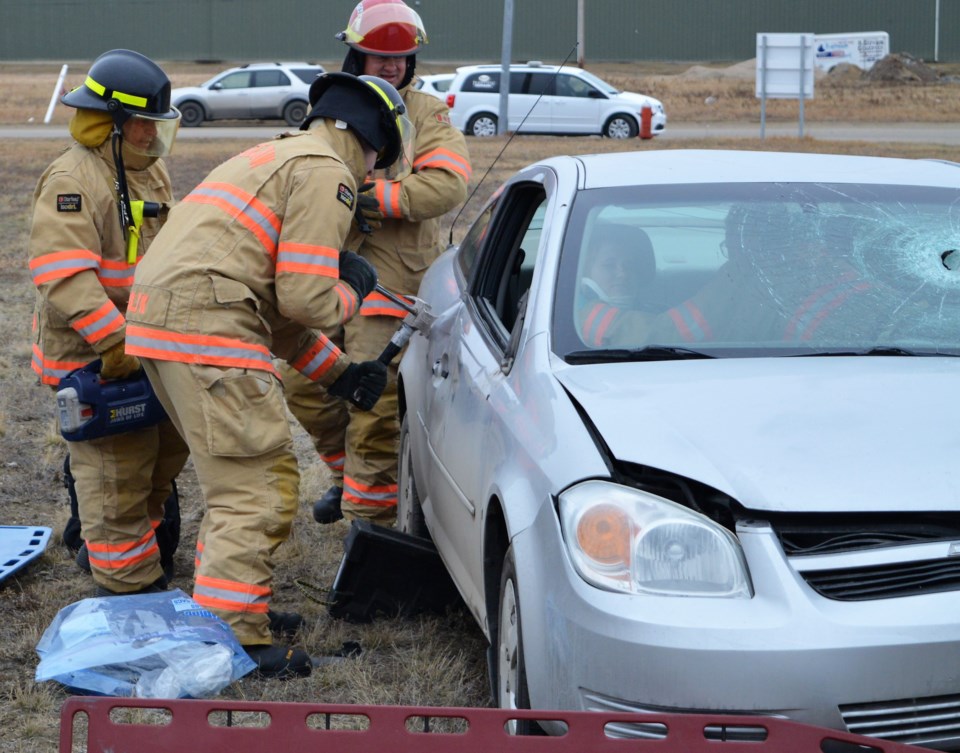MOOSE JAW — Saskatchewan Government Insurance (SGI) is creating a $5.6 million fund to equip volunteer firefighters with tools such as the “Jaws of Life”, and provide them with the training to safely operate those tools.
Volunteer firefighters responding to motor vehicle accidents on Saskatchewan roads sometimes find victims entrapped by crushed and distorted metal and plastic – if they don’t have the tools and training, they have no choice but to wait for backup.
Nathan Heinen, fire chief of the volunteer firefighter department in Craik, said that vehicle extrication tools haven’t been around in his department for 15 to 20 years.
“They did have them, but they decided to donate them to another department,” Heinen told MooseJawToday.com. “But that’s long, long before my time.”
Heinen said that it isn’t usually an issue because they have a mutual aid agreement with the Davidson Fire Department. When a motor vehicle collision with possible entrapment occurs in their area, they call Davidson to come out with tools and a five-person team.
“In trauma situations, you have what’s referred to as the ‘golden hour,’” explained Doug Lapchuk, fire chief of the Balgonie Volunteer Fire Department and president of the Saskatchewan Volunteers Fire Fighters Association (SVFFA). “Anything over that (hour), your success rate diminishes. So if you’re waiting an hour for extrication, you’ve already used up that golden hour and you still have not gotten the patient medical care.”
There are nearly 300 volunteer firefighting agencies in Saskatchewan, many of them remote.
“This program will greatly enhance our abilities to safely and adequately respond to motor vehicle collisions involving entrapment,” Lapchuk said, “in far more areas of our province that currently may not have extrication services available in a timely manner.”
Heinen said that it isn’t as simple as having the tools, either. Firefighters have to know the vehicle’s structural characteristics and safety features, or they risk making the situation worse.
“Advancements in vehicle technology have led to new materials and designs in modern automobiles,” said Dona Morgan, Minister Responsible for SGI. “Volunteer firefighters are often the first to respond to collisions on highways and rural roads, and it is essential that volunteer fire departments are kept up-to-date with evolving tool developments and adaptations around new car designs.”
The program is the first of its kind in Canada. There are two objectives:
- Funding the delivery of training courses for volunteer firefighters to meet auto extrication standards
- Purchasing the tools and equipment
The fund will be managed and distributed by the Saskatchewan Public Safety Agency (SPSA). SPSA will consult with SGI, fire service stakeholders, the Provincial Standards Training Committee, and other government ministries.
The process for rolling out the program is still underway, said Lapchuk, who is on the organizing committee. Blanket coverage across the province would be ideal, but they are also examining historical records to see if certain departments have an urgent need for extrication tools based on their incidence rate.
The other important factor is the willingness and capability of smaller departments that may not have enough personnel to participate in training.
Lapchuk couldn’t say how far the money will go, because there are different levels of equipment – a small coupe is easier to open than a school bus or heavy truck – ranging from basic hand tools to heavy hydraulics.
The last time the Balgonie Fire Department replaced their jaws was eight years ago, Lapchuk said, and the hydraulic tools alone cost $32,000. Firefighters train with the hydraulics on an ongoing basis, pushing the cost even higher.
A tentative cost of $50,000 per department would allow for the outfitting of 112 volunteer firefighter departments – a higher level of coverage across the province that could potentially save lives.



